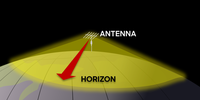Effective Earth radius

The earth is like a big ball that we live on. It's really big, so it has a bunch of different layers. One of those layers is called the "atmosphere" - that's the air around the earth that we breathe.
When things travel through the atmosphere - like radio waves or signals that power our phones and TVs - they can get slowed down or bounced around a bit. Scientists use something called the "effective Earth radius" to help figure out how this happens.
The effective Earth radius is like a special number that helps scientists pretend like the earth is a smaller ball than it really is. That way, they can use simpler math to predict how radio waves and signals will travel through the atmosphere.
It's kind of like if you were trying to play with a really big toy car in a really small room - it might be hard to figure out where the car will fit or how it will move. But if you pretend that the room is smaller, it could be easier to play with the car.
So when scientists talk about the effective Earth radius, they're basically saying "let's pretend the earth is smaller than it really is so we can figure out how radio waves and signals will behave."
When things travel through the atmosphere - like radio waves or signals that power our phones and TVs - they can get slowed down or bounced around a bit. Scientists use something called the "effective Earth radius" to help figure out how this happens.
The effective Earth radius is like a special number that helps scientists pretend like the earth is a smaller ball than it really is. That way, they can use simpler math to predict how radio waves and signals will travel through the atmosphere.
It's kind of like if you were trying to play with a really big toy car in a really small room - it might be hard to figure out where the car will fit or how it will move. But if you pretend that the room is smaller, it could be easier to play with the car.
So when scientists talk about the effective Earth radius, they're basically saying "let's pretend the earth is smaller than it really is so we can figure out how radio waves and signals will behave."
Related topics others have asked about:
